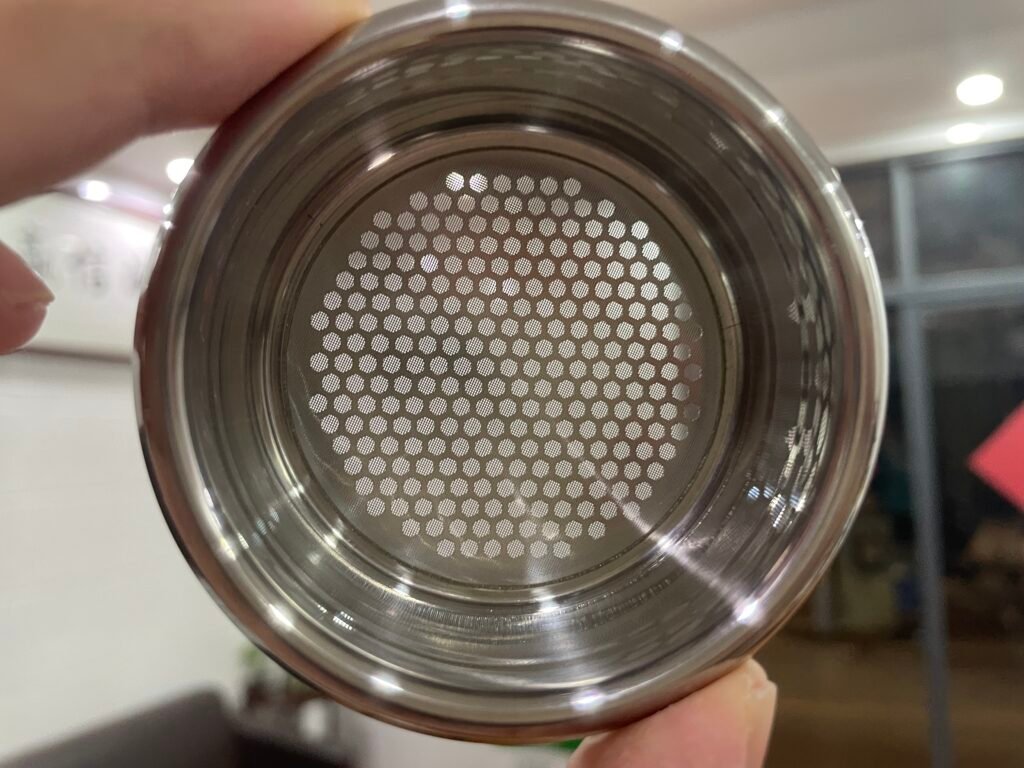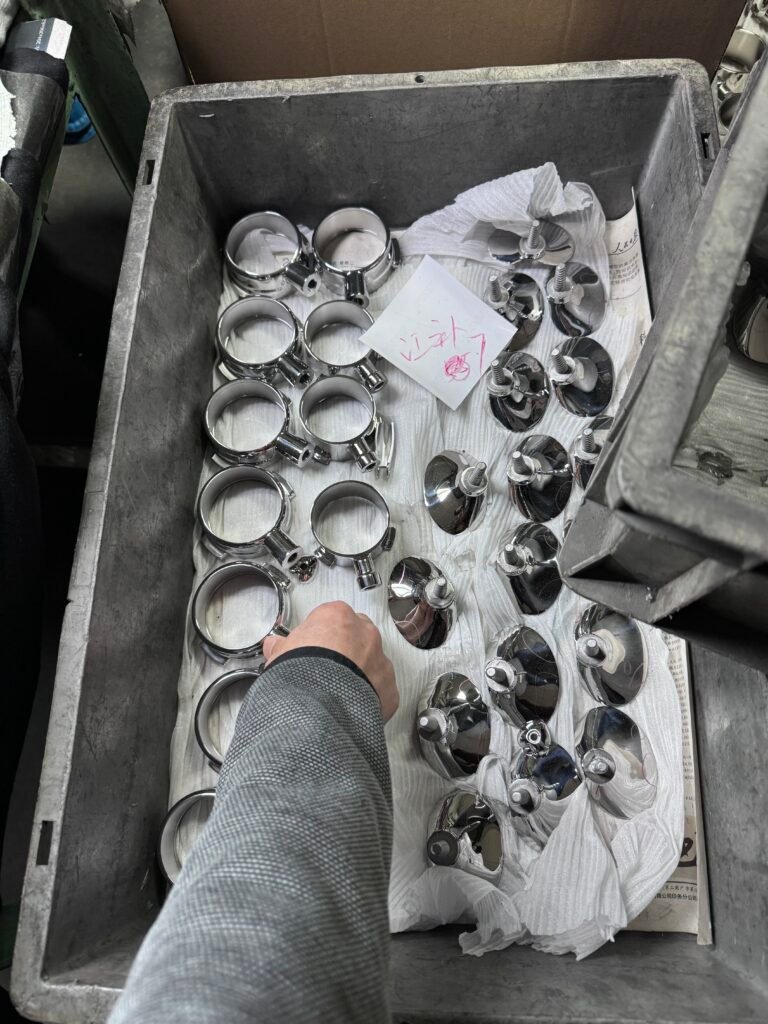Engineering the Perfect Coffee Basket: Material Science Behind Premium Coffee Accessories
Coffee basket quality directly impacts your espresso's flavor and extraction. Poor design leads to channeling, uneven extraction, and disappointing shots that waste your premium beans.
The perfect coffee basket combines material science and precision engineering to control water flow and pressure distribution. Premium baskets use food-grade 304/316 stainless steel with laser-measured perforations that ensure consistent extraction temperature, flow rate, and ultimately better-tasting espresso.

Let's look at the technical side of coffee basket manufacturing. I've been in this industry for years and have seen how the right materials and engineering make a big difference in the final cup quality. My factory produces thousands of precision baskets monthly, and I want to share what makes some baskets stand out from others.
What materials are used in premium coffee baskets[^1]?
Coffee baskets may look simple, but poor-quality materials can lead to metallic taste, corrosion, and even potential health concerns. This ruins the delicate flavors in your espresso.
Premium coffee baskets use food-grade 304 or 316 stainless steel[^2] with 18-8 composition (18% chromium, 8% nickel), ensuring corrosion resistance[^3] and zero taste transfer. These materials maintain structural integrity under high pressure (9+ bars) while meeting strict FDA and LFGB safety standards.

Material Properties Comparison: 304 vs. 316 Stainless Steel for Coffee Baskets
The difference between average and exceptional coffee baskets often comes down to material selection. In our factory, we've tested various steel compositions to identify optimal properties for espresso extraction. The two most common food-grade stainless steels used in premium coffee baskets are 304 and 316.
| Property | 304 Stainless Steel | 316 Stainless Steel |
|---|---|---|
| Chromium Content | 18-20% | 16-18% |
| Nickel Content | 8-10.5% | 10-14% |
| Molybdenum | None | 2-3% |
| Corrosion Resistance | Good | Superior |
| Temperature Stability | High | Very High |
| Cost | More Affordable | Premium |
| Best Application | Standard commercial use | High-volume or marine environments |
The addition of molybdenum in 316 stainless steel provides enhanced corrosion resistance, particularly against chlorides and acids found in water. This makes 316 ideal for commercial environments with intensive cleaning regimens or coastal areas where salt air can accelerate corrosion. However, for most applications, properly manufactured 304 stainless steel baskets offer excellent performance with better cost efficiency. Our testing shows that the material thickness and hole precision actually have more impact on extraction quality than the difference between these two grades when used in standard environments.
How does hole precision affect extraction quality?
Uneven hole distribution leads to channeling where water finds the path of least resistance. This means some coffee grounds over-extract while others remain under-extracted, creating bitter or sour notes.
Premium baskets feature precision-drilled holes (typically 0.3-0.4mm diameter) in symmetrical patterns with consistent spacing. Advanced manufacturing uses CNC machines with ±0.01mm tolerance, creating even resistance across the basket base for balanced extraction and superior flavor clarity.

The Science of Hole Pattern Engineering in Coffee Baskets
The pattern and precision of perforations in a coffee basket directly influence extraction dynamics. In our manufacturing facility, we use computer-controlled drilling with micron-level precision to create optimal flow characteristics. The relationship between hole size, quantity, and arrangement requires careful engineering balance.
Our research shows that basket hole patterns fall into three main categories, each with distinct extraction properties:
Hole Pattern Comparison Table
| Pattern Type | Hole Configuration | Extraction Characteristics | Best For |
|---|---|---|---|
| Uniform Grid | Evenly spaced holes in straight rows | Predictable, consistent extraction | Medium roasts, balanced blends |
| Radial | Holes arranged in concentric circles | Promotes even pressure distribution | Light roasts, single origins |
| Compound | Variable density patterns | Controls flow rates across basket | Specialty coffees requiring precise flow control |
The number of holes also significantly impacts extraction. Standard commercial baskets typically contain 400-600 holes, while precision baskets may feature 800-1,200 holes of smaller diameter. This higher hole count with smaller perforations creates more uniform resistance and prevents channeling, especially with finer grinds.
The basket's sidewall angle and base thickness also play crucial roles. We've found that a slight conical shape with walls angled at 2-3° helps direct pressure evenly, while a base thickness of 0.8-1.2mm provides optimal structural integrity without compromising heat transfer.
What are the latest innovations in coffee basket technology[^4]?
Traditional basket manufacturing techniques limit precision and consistency. Mass-produced baskets often have rough edges, uneven holes, and poor surface finish that affect extraction quality.
Cutting-edge baskets now utilize nano-coating technology[^5], advanced CNC machining[^6] with tolerance levels of ±0.005mm, and specialized heat treatments that stabilize metal properties. Some premium baskets feature dual-layer construction or variable hole density patterns that optimize extraction zones across the basket diameter.

Breakthrough Technologies in Coffee Basket Manufacturing
The coffee basket industry has seen remarkable technological advancement in recent years. In our facility, we've invested in state-of-the-art manufacturing processes that bring precision engineering to coffee extraction. These innovations address problems that have challenged baristas for decades.
One significant breakthrough is the development of multi-stage punching processes. Traditional single-punch manufacturing creates micro-burrs around basket holes, disrupting water flow and collecting coffee oils that eventually turn rancid. Our multi-stage process includes:
- Initial precision punching
- Deburring treatment
- Surface polishing
- Quality control inspection using digital microscopy
This comprehensive approach eliminates the microscopic imperfections that affect extraction consistency over time. Additionally, we've developed proprietary coating technologies that enhance the basket's surface properties:
| Coating Technology | Benefits | Application |
|---|---|---|
| Electropolishing | Removes microscopic surface irregularities | Improves cleanability and reduces coffee oil adhesion |
| Passive Layer Enhancement | Strengthens chromium oxide formation | Increases corrosion resistance and longevity |
| Nano-texture Treatment | Creates uniform surface energy across basket | Promotes even water distribution during extraction |
Another innovation is variable thickness manufacturing, where the basket base features optimized thickness zones that maintain ideal thermal properties while ensuring structural integrity under pressure. This technique allows for thinner perforated areas (improving heat transfer) while maintaining stronger structural zones.
Conclusion
The perfect coffee basket combines premium materials, precision engineering, and advanced manufacturing techniques. When selecting baskets for your business, these technical details directly impact extraction quality and ultimately your customers' satisfaction.
---
[^1]: Explore the advantages of premium coffee baskets to enhance your espresso experience and ensure quality in every cup.
[^2]: Understanding the differences can help you choose the right materials for your coffee baskets, ensuring safety and quality.
[^3]: Learn how corrosion resistance plays a crucial role in maintaining the flavor and safety of your coffee.
[^4]: Explore advancements in coffee basket technology to enhance your brewing experience and extraction quality.
[^5]: Discover how nano-coating technology can elevate your coffee brewing by improving basket performance and durability.
[^6]: Learn about CNC machining's precision in coffee basket manufacturing and its impact on extraction quality.



